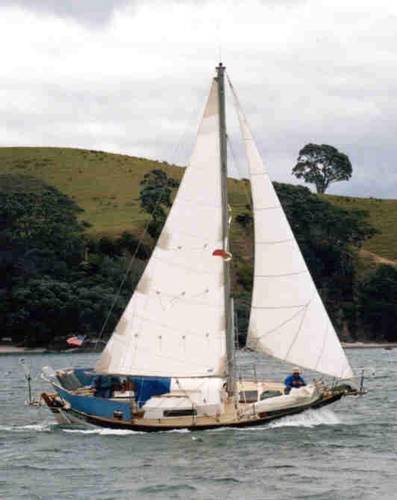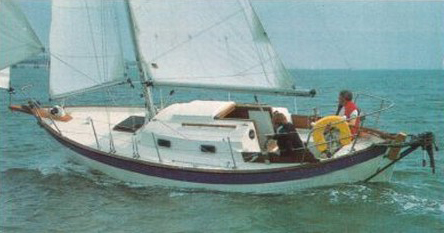 Yachting and Boating Magazine test sail a Frances
Yachting and Boating Magazine test sail a Frances
It was on a distinctly chilly clay that I met Peter Gregory
of Victoria Marine at his Southampton office. Nevertheless, the sun was out and there was
a good breeze, so clad in warm wear and windproofs we soon got underway
in the Frances 26.
We motored downriver using the Volvo 7.5 hp diesel engine which, after
pointing out that it was cold and therefore did not expect to be taken
out and used, settled to a quiet well insulated rythym. There is plenty
of power and the boat will turn in a close circle going astern. It is
very well controlled because of the large area of the rudder, but for
the same reason once the boat gathers sternway, only small movements at
the tiller should be made, and then with a firm grip or you will find
it quickly snatched and slammed over. The Frances is, of course, a double
ender' so it gathers sternway much quicker than a 'transom' boat.
Once clear of the various shipyards and marinas we set sail: the rig has
a high aspect mainsail and a 7/8 rig for the headsail which is also self
tacking. Both the main and jib have slab reefing. The rig-is all very
straight forward and simple to operate; tacking is achieved by simply
pushing the tiller, the sails look after themselves. I have two criticisms
of the rig, both of which start to make life more complicated. The first
is easily dealt with: the self-tacking jib has a single lead aft and is
cleated outside the starboard, cockpit coaming ~ no problem until you
are hard on port tack and want to bear away and clear that cleat, you
are leaning outboard and downhill. The solution is simple; make the sheet
double ended so you can always clear to windward.
My second point is the fixed runners, necessary because of the fractional
rig. They are fixed, I assume, to do away with levers or tackles or jobs
to do when tacking, but they are at such an acute angle to the forestay
they must create more compression downwards through the mast than tension
on the forestay. Both of these criticisms, or rather their cures, create
more string and complicated sailing which defeats the boat's objective.
The headsail tuft was reasonable, it is of course, relatively small (basically
a staysail) in order to be able to self-tack.
Once clear of the river and in Southampton Water I settled comfortably
onto the stern locker seat and throughly enjoyed my sail, the boat is
extremely light on the helm, in fact the boat will almost sail itself
once the sails are trimmed. The underwater body has a long full keel shape
fore and aft while the hull itself is round with the keel looking in profile
almost like a dagger board. This seems to give the best of both fin and
full keel worlds.
The keel is cut away at the fore foot which helps the tacking capabilities
although it still pays to sail the boat round rather than spin it. Off
the wind goose winging is easy, the headsail behaves itself and is quiet
and efficient on its boom while the long keel and full rudder keep it
steady on course.
Moving about on the deck is a dream, there are no ropes or blocks or tracks
to trip or slip on and the high gunwales give an excellent feeling of
security.
The original design of this boat (by American Chuck Paine) was for a flush
deck (that option is still available) which must have made the boat a
real beauty: modern-day sailers, however traditional they claim to be,
have forced the builders to give more headroom by adding a cabin top.
The boat is still pretty, particularly with a colored top strake which
tends to hide the cabin.

The cabin top has no lining but is well coated with anticondensation paint, which obviously works. The cabin sides where they are visible are lined with a timber strip planking which is very pleasent and warm, an enterprising owner might well continue this round the cabin top. The alternative layout I have seen only briefly, but it basically provides a more secluded loo in its own compartment aft and is more split up than the open plan version, the choice is yours.
I believe the Frances 26 will appeal to the modern traditionalist and to anyone that does not want to be continuously tweaking his rig. During my test the looks on the crew of a nearby yacht were interesting, as we approached they were "that's a pretty little boat" gradually changing to quiet anguish as they realised we were passing them - it was a much larger boat and no amount of rope pulling stopped the gap opening. It is worth remembering that the Frances 26's performance is belied by the ease with which it is achieved.